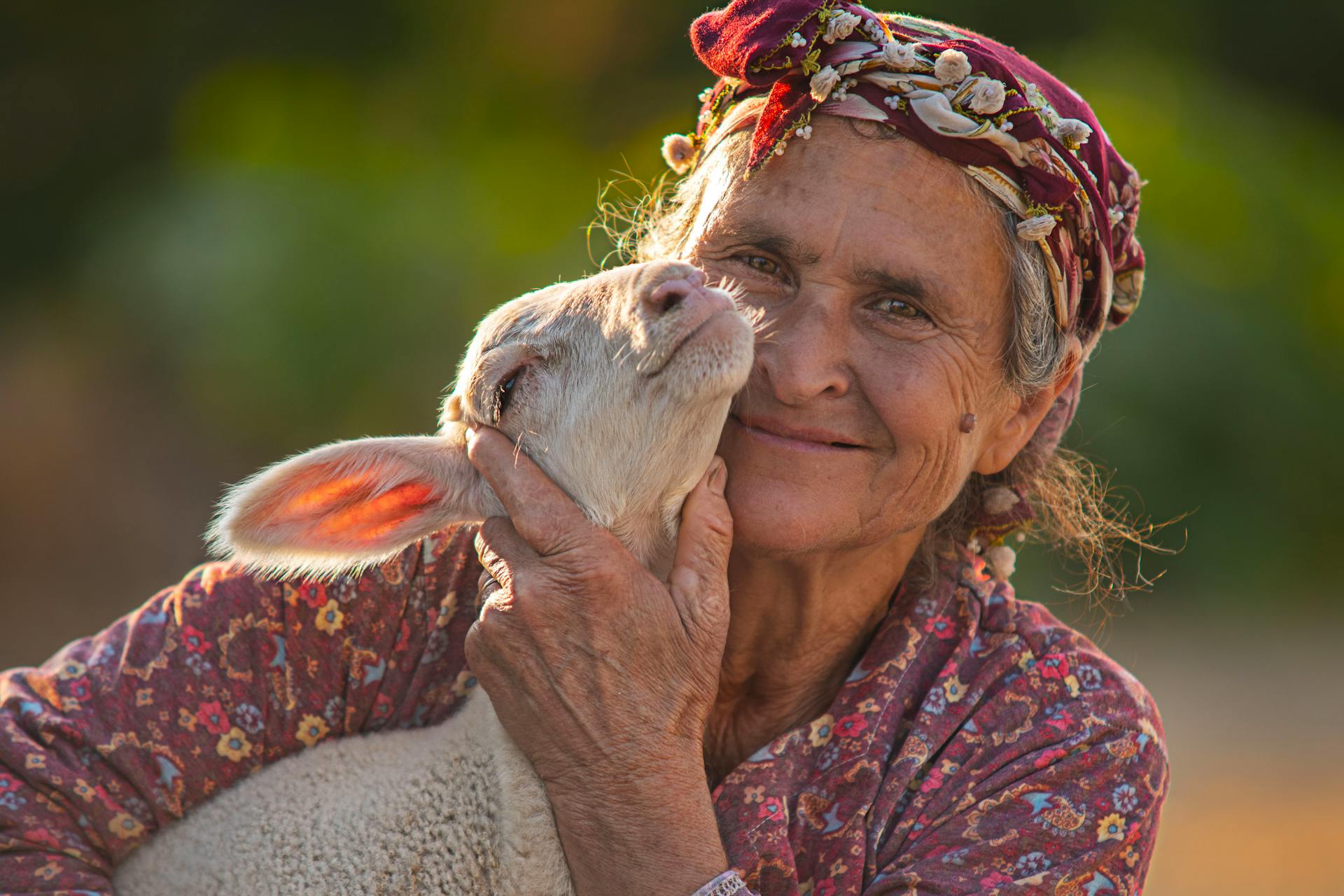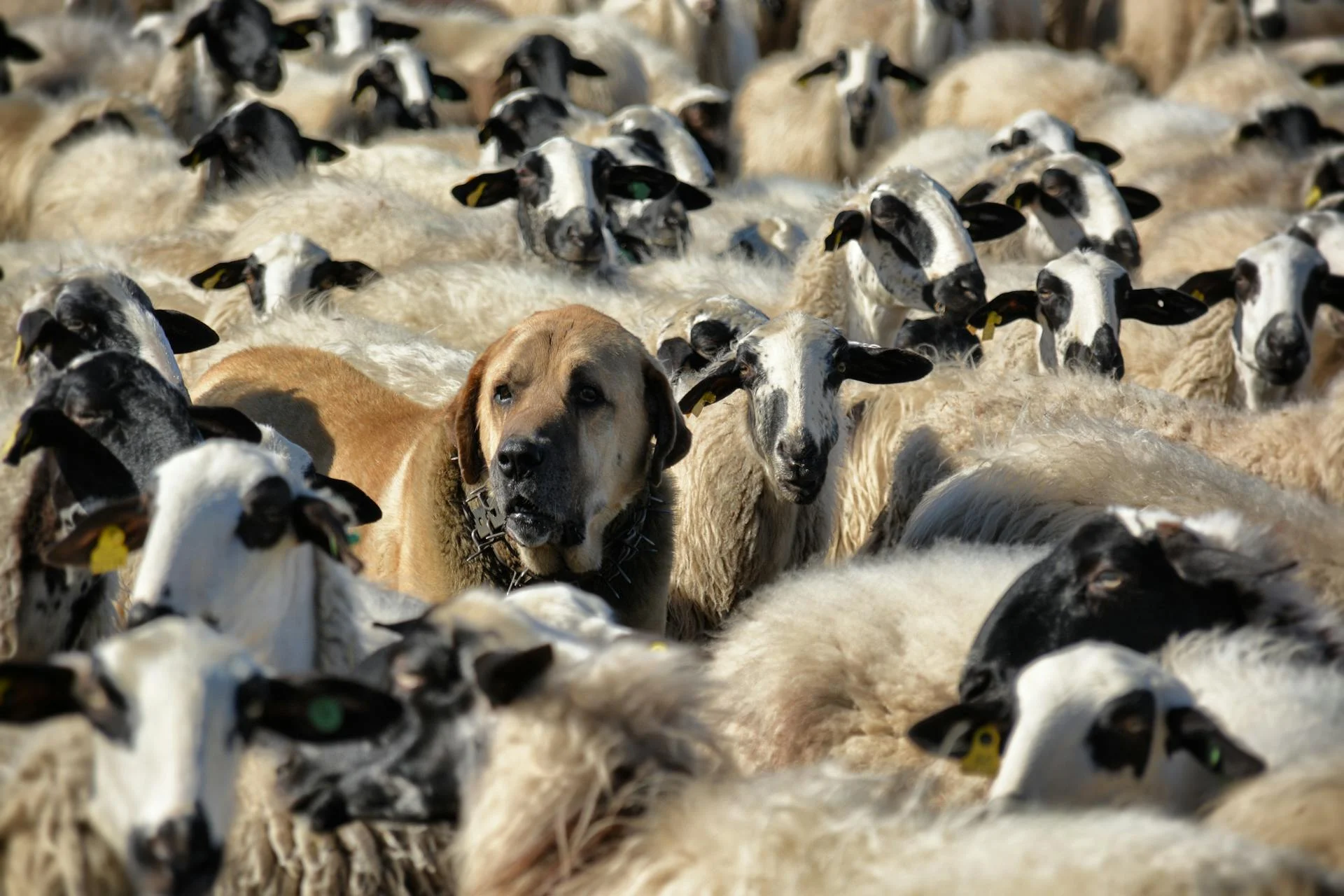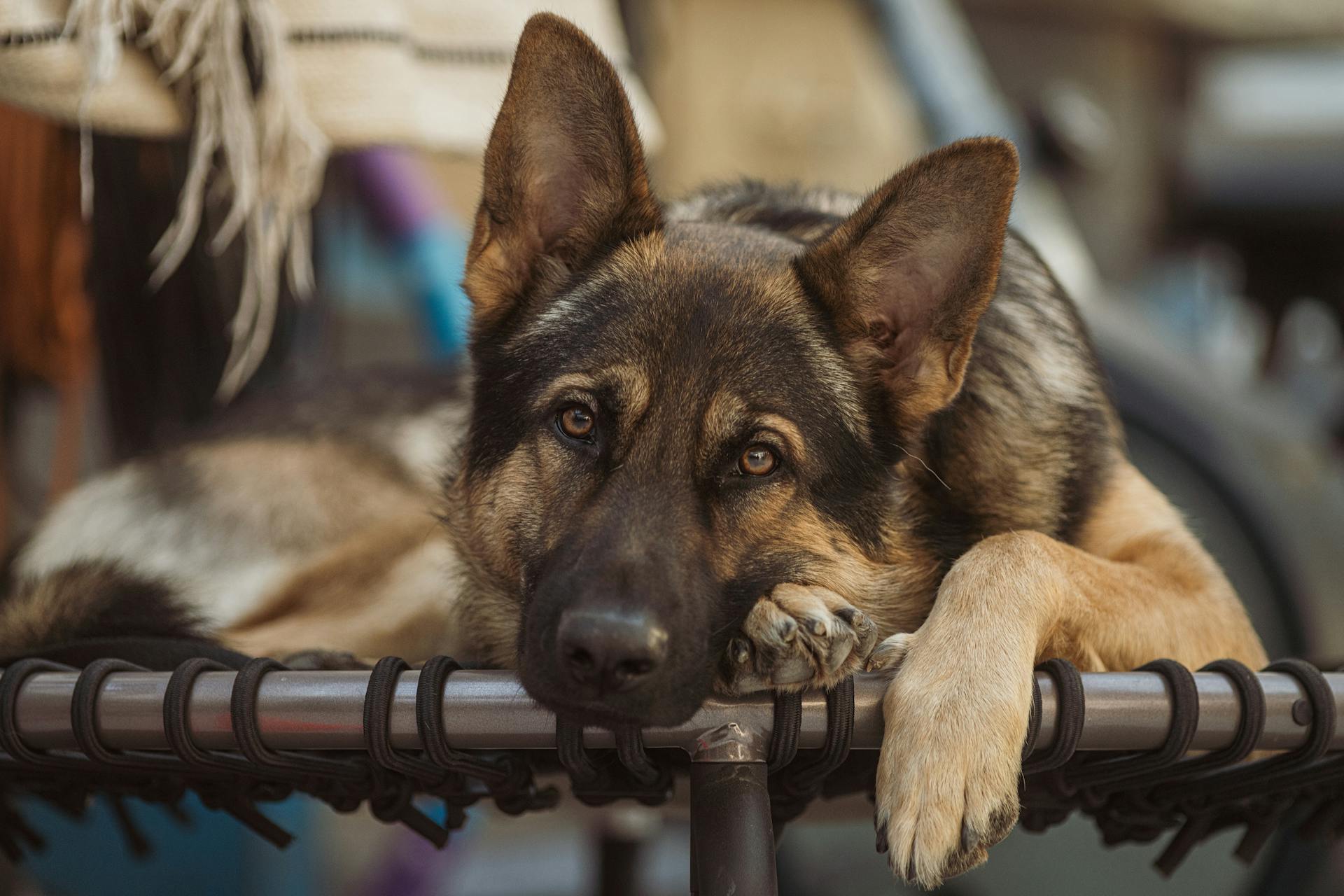
The Caucasian Ovcharka is a large and powerful breed of guard dog that originated in the Caucasus region.
They were bred to protect livestock from predators like wolves and bears.
This breed is known for its loyalty and protective instincts, making them a popular choice for families and farmers.
The Caucasian Ovcharka is a highly intelligent breed that requires early socialization and training to prevent aggression.
They are naturally wary of strangers and can be wary of other animals, which makes them excellent watchdogs.
Additional reading: Dogs Breeds That Start with B
At a Glance
The Caucasian Ovcharka is a formidable guard dog that demands respect. They can grow up to 27-30 inches in height and weigh between 110-170 pounds.
Their size and strength require a sturdy fence to contain them, so don't even think about a flimsy picket fence. High and strong fencing is a must.
These dogs are relatively low-maintenance when it comes to exercise, but they still need some physical activity to stay happy and healthy. A daily walk or playtime should suffice.
One thing to keep in mind is that they can be stranger-aggressive, so socialization is key. With proper training and care, they can be great with children and make wonderful family pets.
Here's a quick rundown of their physical characteristics:
They have a double coat that comes in short-, medium-, and long-haired varieties, and their grooming needs are relatively low-moderate.
Article Contents
The Caucasian Ovcharka is a loyal and protective breed, known for its strong personality and temperament. They can be wary of strangers, making them excellent guard dogs.
One of the most distinctive traits of the Caucasian Ovcharka is its ability to guard livestock. This is due to its inherent instinct as a livestock guardian dog, which makes it a valuable asset for farmers and ranchers.
The Caucasian Ovcharka is also a popular pet, known for its gentle nature with its family. However, it's essential to remember that they are still a large and powerful breed.
The history of the Caucasian Ovcharka dates back to ancient times, when it was used to guard livestock in the Caucasus region. This breed has been around for thousands of years, making it a true ancient breed.
In terms of appearance, the Caucasian Ovcharka is a large dog with a thick coat that requires regular grooming. They come in a variety of colors, including white, black, and brindle.
A well-balanced diet is essential for the Caucasian Ovcharka, as it requires a significant amount of food to maintain its size and energy levels. A diet rich in protein and fat is recommended.
The average lifespan of the Caucasian Ovcharka is 10-12 years, making it a long-term companion. With proper care and attention, they can live a happy and healthy life.
The cost of owning a Caucasian Ovcharka can vary greatly, depending on factors such as location and breeder reputation. On average, you can expect to pay between $500 to $1,000 for a puppy.
Here are some common health concerns associated with the Caucasian Ovcharka:
- Dilated Cardiomyopathy
- Hip Dysplasia
- Elbow Dysplasia
- Eye problems
If you're considering bringing a Caucasian Ovcharka into your family, it's essential to research similar breeds, such as the Central Asian Shepherd, to ensure you find the right fit for your lifestyle.
Breed Overview
The Caucasian Ovcharka is a unique breed that originated in the Caucasus Mountain area between the Black and Caspian Seas. They were developed to protect flocks of sheep from human and animal predators.
This breed is known for its assertive and strong-willed nature, with some exhibiting ferocious and unmanageable tendencies while others can be warm and loving with family and acknowledged friends. They are not recommended for apartment living or for homes with small children.
The Caucasian Ovcharka comes in two coat varieties: long and short. They can be more active at night and often lethargic during the day due to their role as nighttime guardians.
Key Characteristics:
- Protective; an excellent guard dog
- Loving and loyal to her owners
- Even temper and gentle disposition
- Confident, steady, and fearless
However, they can be overprotective of family and territory if not socialized properly, and may be aggressive toward people and dogs. Proper socialization as a puppy is crucial to avoid aggression as an adult.
Personality/Temperament
The Caucasian Ovcharka is known for being an independent and dominant breed. They're highly territorial and fearless, which makes them excellent guard dogs.
One of the unique characteristics of the Ovcharka is their lower energy levels compared to other livestock guardian dogs. They're happy to spend their days lounging under a tree, scanning for potential threats.
If you're considering bringing an Ovcharka into your home, be aware that they require proper socialization from an early age to avoid aggression towards people and dogs. This is crucial to ensure they grow into confident, steady, and fearless companions.
Here are some key personality traits to keep in mind:
- Protective and loving towards family and owners
- Can be overprotective and aggressive if not socialized properly
- Requires an experienced and confident leader
- May need supervision around children
The Ovcharka's strong will and assertive nature make them a great fit for experienced dog owners who can provide the necessary training and attention. However, they may not be the best choice for apartment living or families with small children.
Guardian Dog History
The Caucasian Ovcharka has a rich history as a livestock guardian dog. Originating in the Caucasus Mountain area between the Black and Caspian Seas, this breed was developed to protect flocks of sheep from human and animal predators.
In the Caucasus Mountains, the herdsmen needed a dog that could stand up to both predators and harsh winters, resulting in the creation of the Caucasian Ovcharka. This mastiff-type dog is known for its legendary protectiveness and ferocity.
The Caucasian Ovcharka was traditionally used in Russia as both a livestock guardian dog and a property dog. Sheepherders often employed these dogs to guard their large flocks of sheep.
The breed is more social than some other livestock guardian breeds, as it likes to work closely alongside shepherds and respond to their direction. This social aspect is essential for the dog's effectiveness as a guardian.
Here are some key facts about the breed's history:
- Place of Origin: Russia
- Traditional Livestock Guarded: Sheep, goats
The Caucasian Ovcharka's history is a testament to its strength and resilience as a breed.
Physical Characteristics
The Caucasian Ovcharka is a powerful breed with a rugged appearance that's well-suited to its origins as a working dog. They have a heavy muscular body and thick coat that protects them from harsh environments.
Their coat comes in three distinctive types: long, intermediate, and short. Long-coated Ovcharkas have a maned appearance with feathering on their hind legs, while short-coated ones lack any feathering or mane.
Here are the key measurements to know:
Their head shape is perhaps their most distinctive feature - a wedged shape with a large skull and blunt muzzle that gives them a bear-like appearance. Their eyes are deep-set and tilted, typically brown in color.
Worth a look: Bull Terrier Head Shape
Appearance
The Caucasian Ovcharka is a landrace breed with a lot of variability in their appearance. They were traditionally bred for their working traits, strength, and durability, rather than for a particular appearance.
Their coats come in three distinctive types: long, intermediate, and short. The long-coated variety has a long outer coat and dense undercoat, giving them a maned appearance and feathering on their hind legs.
The breed's colors are quite diverse, excluding black, blue, or chocolate. They often have piebald or spotted patterns, and distinct markings around their eyes that resemble spectacles.
The Caucasian Ovcharka's head is one of its most distinguishable features, with a wedged shape and very large skulls. Their eyes are deep-set, tilted, and typically brown in color.
Their ears are high-set and traditionally have been cropped, although ear cropping is now illegal in some areas of Europe due to the pain it causes. Their neck is short but extremely muscled.
Their body is heavily built, with a broad chest and slightly tucked-under abdomen. Their paws are heavy, large, and have hair between their toes to keep them protected and insulated.
The breed's tail is typically curled over the back in a hook-shape when excited or hanging naturally downward when at ease.
Discover more: When to Mate Female Dog
Size
The Caucasian Ovcharka is a sturdy breed with a size that's perfect for guarding livestock. The height of a male Caucasian Ovcharka ranges from 27 to 30 inches.
Their weight is equally impressive, with males typically weighing between 110 and 170 pounds.
The female Caucasian Ovcharka is slightly smaller, with a height range of 25 to 28 inches.
Their weight is also slightly less, with females typically weighing between 100 and 150 pounds.
Take a look at this: Xl Bully Height
Caring for Your Pet
Caring for your Caucasian Ovcharka is a big responsibility, but with the right routine, you'll be able to keep your furry friend happy and healthy.
Brush their coat at least weekly to prevent excessive shedding and mats. Regular brushing will also help prevent painful ear infections and keep their nails trimmed.
A high-quality diet is essential for your Ovcharka's overall health. Feed them a consistent diet and avoid giving them people food, as this can lead to digestive problems.
Exercise is also crucial for your Ovcharka's physical and mental well-being. Start with regular walks and playtime, but be careful not to overdo it, especially when they're young.
Here's a quick rundown of the routine care your Ovcharka needs:
- Brush their coat at least weekly
- Clean their ears weekly
- Trim their nails regularly
- Brush their teeth at least twice a week
- Feed a high-quality diet consistently
- Exercise regularly, but not too much
By following this routine, you'll be able to keep your Caucasian Ovcharka happy, healthy, and well-cared for.
Health and Wellness
The Caucasian Ovcharka is a giant breed, which means they're prone to large-breed health problems like bone and joint disorders.

They typically live around 10 to 12 years, so it's essential to provide proper nutrition and plenty of exercise to ensure they live a long and healthy life.
Brushing your dog's teeth daily will prevent periodontal disease, which is a common issue in many breeds.
Caucasian Ovcharkas are susceptible to bacterial and viral infections like parvo, rabies, and distemper, but these are often preventable through vaccination.
Regular veterinary check-ups can help identify potential health issues early on, giving you the best chance to prevent or manage them.
Lifespan
Caucasian ovcharkas are a giant breed of dog, which means they are prone to large-breed health problems like bone and joint disorders.
They typically live around 10 to 12 years, and like any dog, require proper nutrition and plenty of exercise.
Most sources agree that Caucasian Ovcharkas live to be between 10 and 12 years, but some have been known to live well beyond that.
Some cases report dogs that lived to 17 years, although this is quite uncommon in the giant breed world.
For another approach, see: Top 10 Guard Dogs for First Time Owners
Health Problems

Caucasian Ovcharkas are prone to large-breed health problems like bone and joint disorders.
They typically live around 10 to 12 years. Proper nutrition and regular exercise are crucial for their overall health.
Hip and elbow dysplasia are common health issues in this breed. Regular check-ups with a veterinarian can help identify any potential problems early on.
Cataracts and obesity are also health concerns that can affect Caucasian Ovcharkas. Maintaining a healthy weight through a balanced diet and regular exercise can help prevent obesity.
Infections such as parvo, rabies, and distemper can affect Caucasian Ovcharkas. Vaccinations can help prevent these infections, and a veterinarian can recommend a vaccination schedule based on the dog's age and other factors.
Daily brushing of your dog's teeth can help prevent periodontal disease. This simple habit can go a long way in maintaining your dog's oral health.
Regular veterinary check-ups can help identify any potential health problems early on, allowing for prompt treatment and prevention of more serious issues.
Discover more: How Much Exercise Does a Bernese Mountain Dog Need
Frequently Asked Questions
Do Caucasian Ovcharka make good pets?
Caucasian Ovcharkas can be loving family pets, but they require experienced owners who can provide strong leadership and a suitable living environment. They may not be the best fit for apartment dwellers or families with small children.
Sources
- https://www.forloveoflivestock.com/blog/caucasian-ovcharka-livestock-guardian-dog-breed
- https://14thstreetvetclinic.com/client-resources/breed-info/caucasian-owtcharka/
- https://www.dogbreedslist.info/all-dog-breeds/caucasian-ovtcharka.html
- https://www.titans-family.com/aggressive-protective-caucasian-shepherd-guard-dog/
- https://www.sheknows.com/living/articles/1119263/caucasian-ovcharka/
Featured Images: pexels.com


